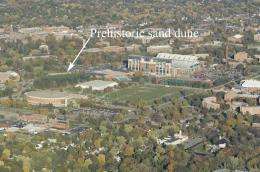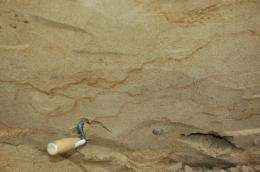MSU Archaeology Team's latest find: 16,000-year-old sand dune

(������ƵOrg.com) -- A team of MSU researchers and archaeology students has confirmed the existence of an undisturbed, prehistoric sand dune beneath a grove of pine trees between Demonstration Hall and Munn Ice Arena.
About 16 millennia ago, when the ice sheets melted on what would become Michigan State University’s campus, tons of sand and other sediment was left behind on a barren, wind-swept landscape.
Fast forward 16,000 years, and a team of MSU researchers and archaeology students has confirmed the existence of an undisturbed, prehistoric sand dune beneath a grove of pine trees between Demonstration Hall and Munn Ice Arena.
“The MSU campus is an odd place in Michigan to find a sand dune,” said Alan Arbogast, an MSU geography professor who helped determine the dune’s age. “This is the first time I’ve ever seen an inland dune this far south.”
The dune is one of the latest finds of the Campus Archaeology Program, said director Lynne Goldstein. Last week, the team also discovered parts of MSU’s first building, College Hall, a classroom/office structure built in 1856 on the present site of Beaumont Tower.
Campus Archaeology, run by the Department of Anthropology and made up mostly of undergraduate and graduate students, is committed to identifying historic and prehistoric sites across the sprawling 5,200-acre campus. While most sites discovered relate to the early years of MSU, some date further back to Michigan’s early pioneer period and others are Native American sites.
The program got its start in 2005 with the much-publicized excavation at the former site of Saints’ Rest, MSU’s first residence hall. The dig team discovered a host of artifacts, including iron woodstoves, glass medicine bottles and a toothbrush made of bone.
Goldstein, a professor of anthropology, said she’s not aware of any other U.S. university “taking the stewardship of its campus as seriously as MSU.” Typically, she said, universities and colleges conduct excavation projects only on special occasions or if state or federal laws require it.
“MSU is the only place I know of that has chosen to do this not because anybody required us to do it, but because the university decided it was the right thing to do,” Goldstein said.

The sloping land on which the sand dune rests was purchased by then-Michigan Agricultural College in 1913. At that time the dune was exposed and eroding on the developing campus, so the following year forestry professor Frank Sanford planted a variety of pine and spruce, which would successfully stop the erosion. Initially about four acres, the plot has been reduced by development to about one acre.
As generations of Spartan fans have made their way through the trees en route to football, hockey and basketball games, it was widely known that sand made up the hill underneath the pine needles. What wasn’t known was the age of the sand.
Then, in spring 2009, MSU’s Landscape Services, a division of ������Ƶical Plant, had to replace storm-damaged trees on the grove. Goldstein and her team coordinate with ������Ƶical Plant to determine if construction or planting will destroy any archaeological sites, and regularly conduct surveys and excavations to identify these sites. With the dune, they were able to examine the sand in two holes (about 4 and 8 feet deep) without the need for a full-scale dig and without harming existing trees.
To determine the age of the sand, Goldstein brought in Arbogast, an expert on Great Lakes sand dunes. A visual inspection convinced Arbogast the dune was very old based on the existence of lamellae - or wavy, reddish bands that run through the sand and indicate long-term soil formation.
The next step was collecting two samples of unexposed sand and sending them off to the University of Nebraska-Lincoln for optically stimulated luminescence, or OSL, dating. Arbogast said the process measures the amount of ionizing radiation that sand grains emit to estimate the last time they were blowing and exposed to light.
The results showed the MSU samples were between 16,100 and 12,400 years old. Based on what is known about the area’s glacial history and Michigan dunes, Arbogast concluded these ages most likely mean the dune was formed shortly after the ice retreated from the area about 16,000 years ago.
“The dune probably formed because northwesterly winds blew sands up from the prehistoric floodplain of the Red Cedar River, which likely also formed shortly after the ice melted,” Arbogast said.
In addition to the rarity of a dune in southern inland Michigan, it’s also uncommon to find a stretch of land on the MSU campus that hasn’t been modified over the years, said Terry Brock, who, as campus archaeologist, helps Goldstein run the Campus Archaeology Program.
“Something we’ve discovered during our excavations over the past couple years is that this whole campus is seriously modified. Even the parts that look natural - the older parts of campus - have been greatly modified,” said Brock, a doctoral student in anthropology.
“But the only modification the pine grove has received is to have trees planted on it, and that was to keep the sand from blowing away,” Brock added. “Everything under the trees is completely natural.”
The pine grove will not be dug up further, Goldstein said, as to not disturb the trees.
Provided by Michigan State University ( : )















